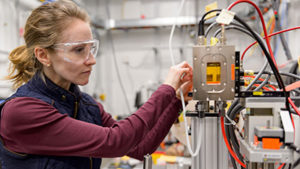Mechanical Engineering Associate Professor Ashley Spear, along with faculty from three other Universities, joined Argonne National Laboratory to build a new X-ray diffraction instrument for users of the Advanced Photon Source (APS). This instrument will enable materials research and clear the way for improvements in advance of the APS Upgrade.
Spear, along with fellow scientists, created a new instrument to accelerate research at one of the world’s most productive X-ray light sources.This new tool will allow more X-Ray experiments to create 3d views of a wide range of materials, enable materials discover and opening new options for users.

The new device, called the High-Throughput High-Energy Diffraction Microscopy Instrument (HT-HEDM), will be housed at the APS and will provide a more assembly line-like approach to obtaining this 3d data. It will enable high-throughput X-ray diffraction imaging experiments, providing a one-stop shop for a range of different studies. This will also enable researchers greater use of the 1-ID beamline for technique development that will be useful when the laboratory’s APS Upgrade comes online in a few years’ time.
“This new instrument will take pressure off the measurements that we’re doing now at 1-ID, so that we can create techniques that take advantage of the added brilliance and coherence of the upgraded storage ring,” said Jonathan Almer, physicist and group leader with Argonne’s X-ray Science division.
HT-HEDM will use high-energy X-rays for nondestructive analyses of materials, creating 3D representations that can be repeatedly observed over time.
The consortium building the instrument includes faculty at and funding from Carnegie Mellon University, Purdue University, the Colorado School of Mines and the University of Utah. Major funding is provided by the National Science Foundation’s Major Research Instrumentation Program; the APS provides extensive personnel, logistics, and engineering support. The APS is supported by the DOE’s Office of Science.
